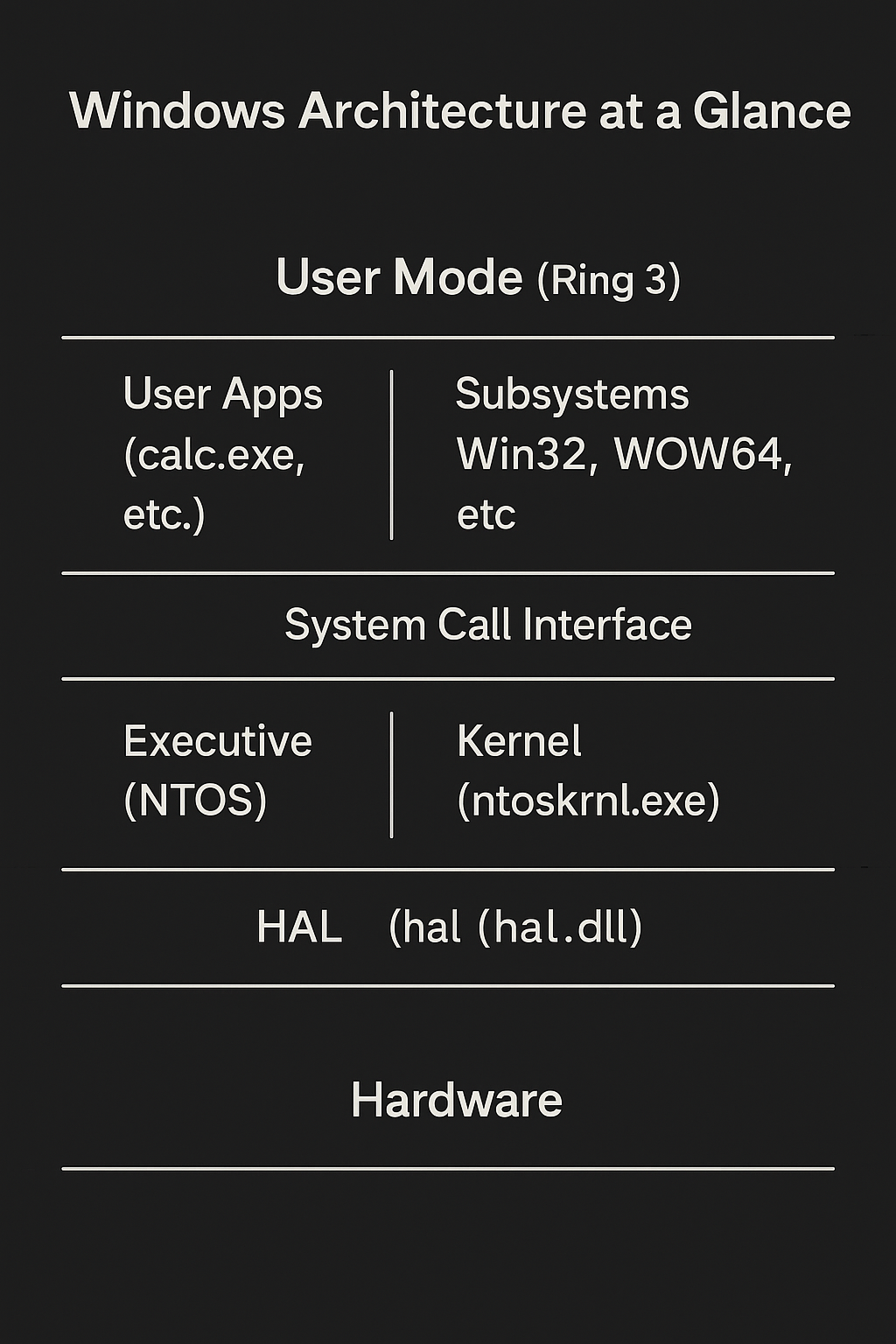Windows OS Architecture
💡 Goal: Understand how Windows is built under the hood — from User Mode to Kernel Mode, system layers, and what makes it tick. This is foundational for everything from malware development to EDR evasion.
Contents
🧠 What is an Operating System?
An OS acts as a middleman between:
- You (the user / programs) and
- Hardware (CPU, RAM, Disk, etc.)
It:
- Manages processes and memory
- Handles file I/O
- Provides APIs to run apps
- Controls devices through drivers

🧩 Key Components Breakdown
🔹 User Mode
- Apps like
notepad.exe,chrome.exe - Can’t directly talk to hardware or manage memory
- Must ask Kernel Mode via System Calls
- Hosts subsystems (e.g., Win32, POSIX, WOW64)
🔸 Subsystems
- Win32: Main API for GUI apps
- WOW64: Lets 32-bit apps run on 64-bit Windows
- POSIX: Legacy support for Unix-style tools
🔸 Kernel Mode
- Has full access to memory, devices, drivers
- Runs privileged code (Ring 0)
- Includes the Kernel, Executive, Drivers, and HAL
🧱 Executive (NTOS)
Think of it as the “brains” of the kernel
Includes:
- Object Manager (handles Windows objects like files, processes)
- Memory Manager (allocates and pages memory)
- Process Manager (creates, manages threads/processes)
- Security Reference Monitor (permission enforcement)
⚙️ Kernel (Core)
- Deals with low-level threading, interrupt handling, synchronization
📦 Device Drivers
.sysfiles likedisk.sys,kbdclass.sys- Run in kernel mode and interact directly with hardware
🧬 HAL (Hardware Abstraction Layer)
- Allows Windows to run on different hardware by abstracting CPU/IO differences
- File:
hal.dll
🔀 User Mode vs Kernel Mode
| Feature | User Mode | Kernel Mode |
|---|---|---|
| Privilege Level | Ring 3 (low) | Ring 0 (high) |
| Memory Access | Own virtual memory | Full system memory |
| Crash Impact | Just the app | Whole system (BSOD) |
| Direct Hardware Access | ❌ No | ✅ Yes |
| Example | explorer.exe | ntoskrnl.exe, disk.sys |
⚙️ System Call Flow (Behind the Scenes)
When you run calc.exe, here’s what happens:
- You click a shortcut
- Explorer.exe launches
calc.exeusingCreateProcess CreateProcess→ Win32 API- Win32 API → System Call (like
NtCreateProcess) - Kernel validates permissions, allocates memory
- Kernel returns handle, app runs
➡️ Every “simple” action is backed by 100+ low-level operations.
🧪 Hands-On Practice
Want to see the layers in action? Try these:
# On Windows PowerShell
Get-Process | Select-Object Name, Path, Id
# Peek into ntoskrnl usage
Get-WmiObject -Query "Select * from Win32_OperatingSystem"
# View loaded drivers (kernel-mode)
driverquery /v
Use Process Hacker or WinDbg to see threads, handles, and kernel objects live.
🧠 Summary
- Windows is a hybrid kernel OS with clear User Mode and Kernel Mode
- User Mode apps can’t touch hardware directly — they rely on System Calls
- Kernel Mode contains the brain (
ntoskrnl.exe), drivers, and HAL - Everything you do — launching apps, copying files — goes through this architecture
Great Detailed